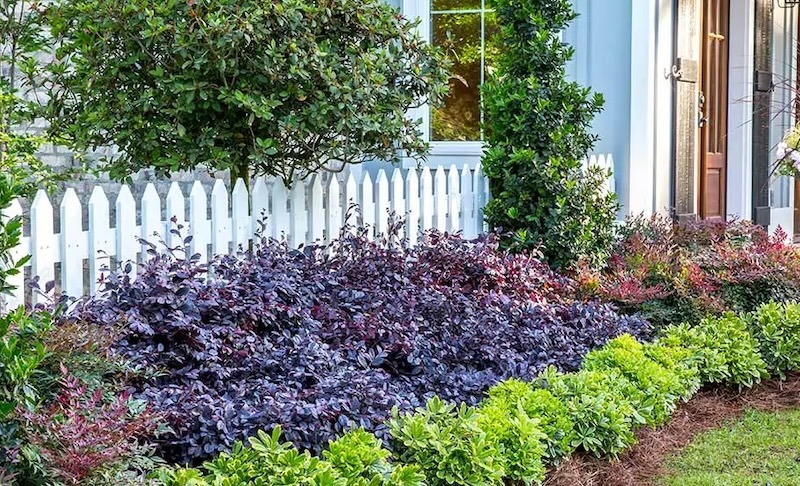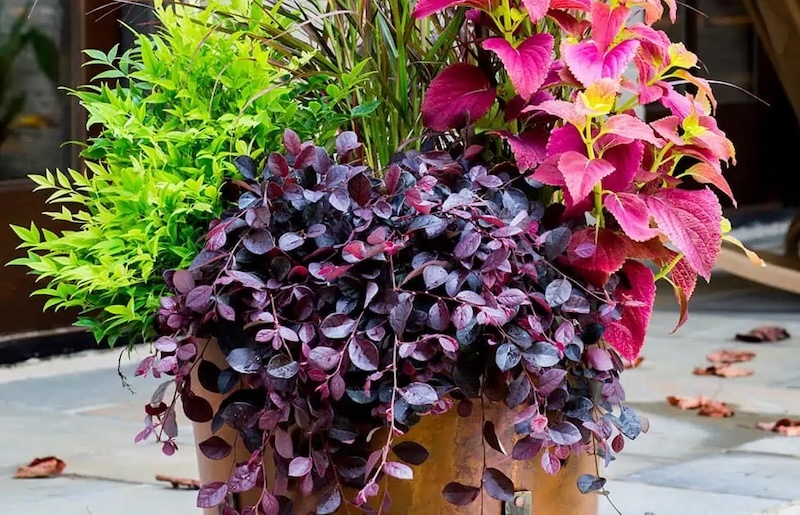The bold foliage of loropetalum ensures this evergreen shrub stands out, making it a natural focal point in a landscape. Also known as Chinese Fringe Flower, the ovate leaves can be lime green or a deep, dark purple. The thin-petaled flowers have a fringe-like appearance and bloom for an extended time in the spring and occasionally throughout the summer. This shrub grows in zones 7 through 10.
The ideal spot for loropetalum receives partial sun to full sun. This evergreen shrub is adaptable and can handle sunny positions, but expect better results when it receives morning sun and protection from intense afternoon sun. Water weekly unless there is rainfall to keep the soil moist. The loropetalum is showy and stands out all on its own, but it makes a wonderful companion for other plants since it introduces vivid color and texture into a landscape.

Shrubs To Plant With Loropetalum
Loropetalum is a warm-weather evergreen shrub that is complemented by the bronzy-red foliage of nandina. Both loropetalum and nandina can grow impressively large, with some loropetalums reaching up to 15 feet tall and nandinas standing up to 8 feet high. While these shrubs can create a bold privacy screen, you can select smaller cultivars to plant in a pot or small garden space.
Create more contrast or visual drama by pairing loropetalum with the green-hued ligustrum. Small, white flowers bloom on the privet from late May through early June and look lovely with the deep pink flowers of loropetalum. Ligustrum can reach up to 10 feet tall but it responds well to pruning and several smaller cultivars are available.
Elderberry is another shrub with white flowers and green foliage that looks wonderful alongside loropetalum. Purplish-black berries in the fall follow the summertime flowers. Elderberry stands out against the evergreen loropetalum and adds contrasting colors and textures.
Perennials To Plant With Loropetalum
Add depth to a mixed planting by featuring a verbena in front of the loropetalum. The long blooming flowers of annual verbena will provide color all season. For a top performer, check out the EnduraScape™ line of verbena. These plants are hardier than others and disease resistant. The pink or purple flowers coordinate with the loropetalum foliage while supporting pollinators. Verbena thrives in full sun but can live in partial sun, making it a good companion plant for loropetalum.

Mix things up by featuring ornamental grasses with loropetalum. The thin, fountain-like shape of the grass provides a balance against the mounded, rounded form of the loropetalum shrub. The tall, feathery flower plumes add more interest and complement the fringe-like loropetalum flowers. For high contrast, try using a shocking chartreuse ornamental grass like carex evercolor ‘Everillo’, which stays evergreen in mild winters and grows well in partial sun.
Annuals To Plant With Loropetalum
Annuals, like begonia, coleus, and verbena, work well with loropetalum because they introduce a new look each year. Begonias need partial sun or shade, so they can live in the same space as loropetalum, but they do best on the north or east side of the shrub so that they will be in the shade cast by the loropetalum. Some of the newer begonias like the Surefire® series can take full sun. Begonias also have increased water needs, so while they don’t like overly wet conditions, they prefer moist soil. The frilly flowers are often in shades of white, red, pink, yellow, purple, or orange, which all work nicely with the dark foliage and flowers of loropetalum.
Best Companion Plants For Loropetalum in Containers
Mixing several plants in one container is a great way to feature different colors and textures on a deck or patio space. The moody foliage colors of heuchera can echo the foliage of loropetalum, while the colorful coleus coordinates while adding a punch of vibrant color. Coleus and heuchera require partial shade or partial sun, although many newer varieties can comfortably live in full sun, aligning it with loropetalum’s sunlight requirements.
A no-fuss option to feature in a container with loropetalum is sweet potato vine. These leafy vining plants make excellent spiller plants. They come in a variety of colors from chartreuse, to play up the contrast with loropetalum, to dark purple for a monotone planting. Some varieties have deeply cut foliage for added texture against the oval leaves of loropetalum. Position sweet potato vine in full sun for best performance.

Plants Not To Grow With Loropetalum
Plants that have drastically different care needs will not do well with loropetalum. Full-shade plants, like ferns, sedums, and azaleas, will fail to thrive in partial sun to shade, or the loropetalum will decline in full sun.
Also, consider the impact this large shrub has on a landscape. Loropetalum can grow large and block sunlight for other plants. Feature plants that need less light in the shady spots created by a full, mature loropetalum.
Best Plants To Grow With Loropetalum
Sunlight and water needs are often the guiding factors when selecting companion plants. Loropetalum needs partial shade to full sun and consistently damp, but well-drained soil. Nandina, sweet potato vine, heuchera and ligustrum are plants with similar care needs, making them suitable neighbors for loropetalum.
 |
Author Alison Cotsonas - Published 01-08-2024 |
